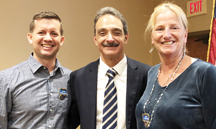It’s most appropriate to comment on “how time flies” when you’re discussing the career and plans of Dr. Habib Dagher, who returned to be a guest speaker after a ten-year hiatus. On 4/2/10, Dr. Dagher, who was then the Professor of Structural Engineering at Maine’s University in Orono, addressed the club relative to the future of off-shore wind farming in Maine. The tale told a decade ago was captivating and we thought we were getting a glimpse of Maine’s future. The vision is still that, but not because of bad science. The science formulated within the wind turbine programs has been a foundation for other award-winning projects that bring further education, worldwide recognition along with money and jobs to Maine. Dr. Dagher was introduced by John Thompson who was invited to visit the lab and see the work first-hand, where he was absolutely enthralled and amazed.
Dr. Dagher has an interesting personal story to go along with his amazing science projects….he was born in Lebanon and his sizable and distinguished family recognized that he was precocious and deserved special attention. They sent him, alone, to live with extended family in Dayton, Ohio and take advantage of further and intensive study. He not only got his Undergraduate Degree, but matriculated for two Masters Degrees, prompting him to take the next logical step and get his PhD in Physical Engineering. The University of Maine was able to attract Habib to come to the school and found the Advance Structures and Composite Center, which is part of the National Science Foundation funding stream.
The Center gained an enormous amount of attention when it came up with a plan to float sizable wind platforms in the Gulf of Maine, where they would be out of sight, but close enough to be functional and serviceable. By harnessing a mere 3% of the wind, the floating turbines could power the entire state at a kilowatt hour rate of 5.7 cents, making one of the most expensive power states in the U.S., one of the least expensive. The structures have already been proven to withstand hurricane force winds. Consequently, the worry of the fury of the sea is put to rest. They hope to build 10 new platforms and turbines within the next few years and start powering the state and exporting the surplus that is a virtual certainty, if ingenuity is not stifled.
The excitement with the “windmills” is palpable. This expedition is going places and the soldiers are people with over 240 real paying high-tech jobs in Maine and others outside the state. They have a contract to do work for NASA and the U.S. Military. The “Bridge in a Bag” is an example of a practical application of the use of carbon fiber to make lightweight durable structures that can be used for domestic purposes, particularly during emergencies, as well as the eventuality of a military need overseas. Imagine two people carrying a couple of hockey bags and within the bags is an easy to assemble bridge structure that only needs cement to become a viable passageway.
One of the best features of the Dr. Dagher’s efforts is that he provides work for 2400 students, making this one of the best work-study projects in Academia!


(Photo L-R: John Thompson, Dr. Habib Dagher and President Amy Chipman.)
